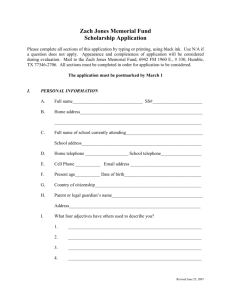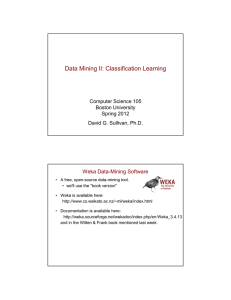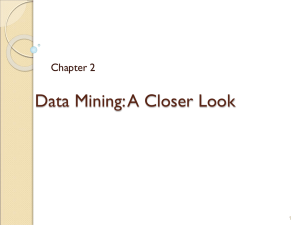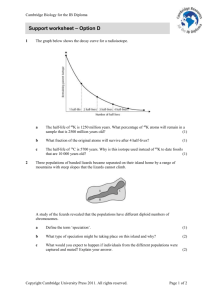Data Mining II: Classification Learning Computer Science 105 Boston University
advertisement
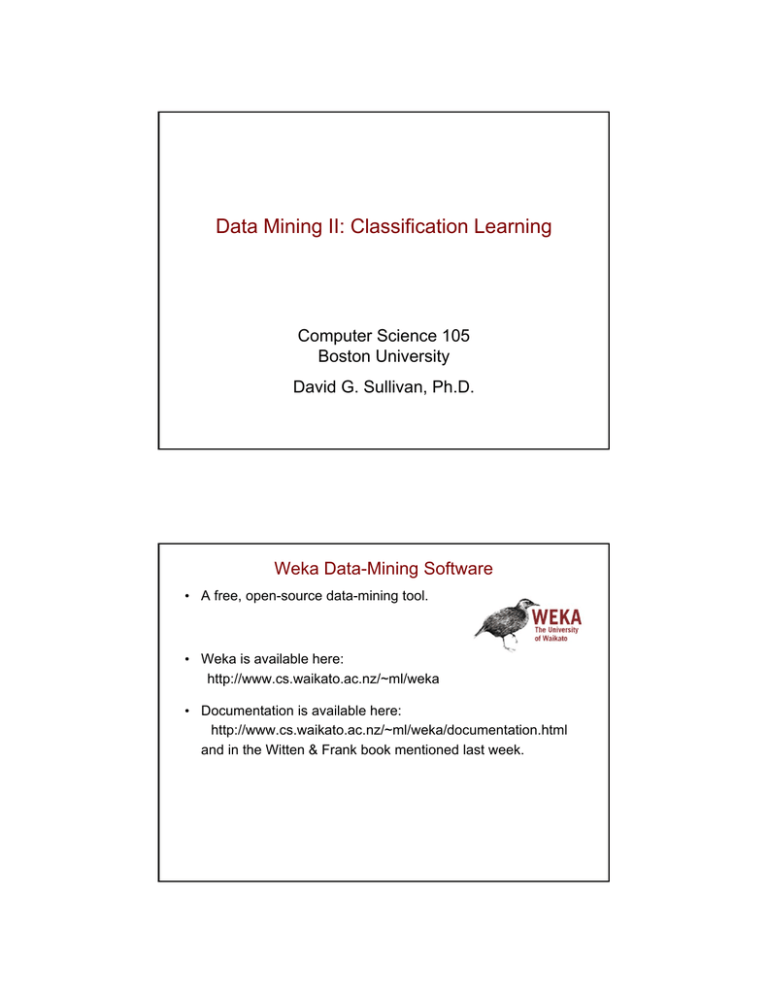
Data Mining II: Classification Learning Computer Science 105 Boston University David G. Sullivan, Ph.D. Weka Data-Mining Software • A free, open-source data-mining tool. • Weka is available here: http://www.cs.waikato.ac.nz/~ml/weka • Documentation is available here: http://www.cs.waikato.ac.nz/~ml/weka/documentation.html and in the Witten & Frank book mentioned last week. Review: Classification Learning • Classification-learning algorithms: • take a set of already classified training examples • also known as training instances • learn a model that can classify previously unseen examples • The resulting model works like this: model input attributes (everything but the class) output attribute/class Review: Classification Learning (cont.) • Recall our medical-diagnosis example: class/ output attribute training examples/instances: Patient ID# Sore Throat 1 2 3 4 5 6 7 8 9 10 Yes No Yes Yes No No No Yes No Yes Fever Swollen Glands Congestion Headache Diagnosis Yes No Yes No Yes No No No Yes Yes Yes No No Yes No No Yes No No No Yes Yes Yes No Yes Yes No Yes Yes Yes Yes Yes No No No No No Yes Yes Yes Strep throat Allergy Cold Strep throat Cold Allergy Strep throat Allergy Cold Cold the learned model: if Swollen Glands = Yes then Diagnosis = Strep Throat if Swollen Glands = No and Fever = Yes then Diagnosis = Cold if Swollen Glands = No and Fever = No then Diagnosis = Allergy Example Problem: Credit-Card Promotions • A credit-card company wants to determine which customers should be sent promotional materials for a life insurance offer. • It needs a model that predicts whether a customer will accept the offer: age sex income range credit-card insurance* model Yes (will accept the offer) or No (will not accept the offer) * note: credit-card insurance is a Yes/No attribute specifying whether the customer accepted a similar offer for insurance on their credit card Example Problem: Credit-Card Promotions • 15 training examples (Table 3.1 of Roiger & Geatz): class/ output attribute Age 45 40 42 43 38 55 35 27 43 41 43 29 39 55 19 Sex Male Female Male Male Female Female Male Male Male Female Female Male Female Male Female Income Range 40–50K 30–40K 40–50K 30–40K 50–60K 20–30K 30–40K 20–30K 30–40K 30–40K 40–50K 20–30K 50–60K 40–50K 20–30K Credit Card Insurance No No No Yes No No Yes No No No No No No No Yes Life Insurance Promotion No Yes No Yes Yes No Yes No No Yes Yes Yes Yes No Yes 1R: Learning Simple Classification Rules • Presented by R.C. Holte in the following paper: Very simple classification rules perform well on most commonly used datasets. Machine Learning 11(2003):63-91. • Why is it called 1R? • R because the algorithm learns a set of Rules • 1 because the rules are based on only 1 input attribute • The rules that 1R learns look like this: <attribute-name>: <attribute-val1> <class value> <attribute-val2> <class value> … • To see how 1R learns the rules, let's consider an example. Applying 1R to the Credit-Card Promotion Data Age 45 40 42 43 38 55 35 27 43 41 43 29 39 55 19 Sex Male Female Male Male Female Female Male Male Male Female Female Male Female Male Female Income Range 40–50K 30–40K 40–50K 30–40K 50–60K 20–30K 30–40K 20–30K 30–40K 30–40K 40–50K 20–30K 50–60K 40–50K 20–30K Credit Card Insurance No No No Yes No No Yes No No No No No No No Yes Life Insurance Promotion No Yes No Yes Yes No Yes No No Yes Yes Yes Yes No Yes • Let's start by determining the rules based on Sex. • To do so, we ask the following: • when Sex = Female, what is the most frequent class? • when Sex = Male, what is the most frequent class? Applying 1R to the Credit-Card Promotion Data (cont.) Age 45 40 42 43 38 55 35 27 43 41 43 29 39 55 19 Sex Male Female Male Male Female Female Male Male Male Female Female Male Female Male Female Income Range 40–50K 30–40K 40–50K 30–40K 50–60K 20–30K 30–40K 20–30K 30–40K 30–40K 40–50K 20–30K 50–60K 40–50K 20–30K Credit Card Insurance No No No Yes No No Yes No No No No No No No Yes Life Insurance Promotion No Yes No Yes Yes No Yes No No Yes Yes Yes Yes No Yes • Thus, we end up with the following rules based on Sex: Sex: Female Yes Male No (6 out of 7) (5 out of 8) Pseudocode for the 1R Algorithm for each input attribute A: for each value V of A: count how often each class appears together with V find the most frequent class F add the rule A = V F to the rules for A calculate and store the accuracy of the rules learned for A choose the rules with the highest overall accuracy • So far, we've learned the rules for the attribute Sex: Sex: Female Yes Male No (6 out of 7) (5 out of 8) overall accuracy = ? • Equivalently, we can focus on the error rate and minimize it. error rate of rules above = ? Applying 1R to the Credit-Card Promotion Data (cont.) Age 45 40 42 43 38 55 35 27 43 41 43 29 39 55 19 Sex Male Female Male Male Female Female Male Male Male Female Female Male Female Male Female Income Range 40–50K 30–40K 40–50K 30–40K 50–60K 20–30K 30–40K 20–30K 30–40K 30–40K 40–50K 20–30K 50–60K 40–50K 20–30K Credit Card Insurance No No No Yes No No Yes No No No No No No No Yes Life Insurance Promotion No Yes No Yes Yes No Yes No No Yes Yes Yes Yes No Yes • What rules would be produced for Credit Card Insurance? Credit Card Insurance: Yes No Applying 1R to the Credit-Card Promotion Data (cont.) Age 45 40 42 43 38 55 35 27 43 41 43 29 39 55 19 Sex Male Female Male Male Female Female Male Male Male Female Female Male Female Male Female Income Range 40–50K 30–40K 40–50K 30–40K 50–60K 20–30K 30–40K 20–30K 30–40K 30–40K 40–50K 20–30K 50–60K 40–50K 20–30K Credit Card Insurance No No No Yes No No Yes No No No No No No No Yes Life Insurance Promotion No Yes No Yes Yes No Yes No No Yes Yes Yes Yes No Yes • What rules would be produced for Income Range? Income Range: 20-30K 30-40K 40-50K 50-60K Handing Numeric Attributes • To handle numeric attributes, we need to discretize the range of possible values into subranges called bins or buckets. • One way is to sort the training instances by age and look for the binary (two-way) split that leads to the most accurate rules. Age 45 40 42 43 38 55 35 27 43 41 43 29 39 55 19 sort by age Sex Male Female Male Male Female Female Male Male Male Female Female Male Female Male Female Income Range 40–50K 30–40K 40–50K 30–40K 50–60K 20–30K 30–40K 20–30K 30–40K 30–40K 40–50K 20–30K 50–60K 40–50K 20–30K Credit Card Insurance No No No Yes No No Yes No No No No No No No Yes Life Insurance Promotion No Yes No Yes Yes No Yes No No Yes Yes Yes Yes No Yes Age: 19 27 29 35 38 39 40 41 42 43 43 43 45 55 55 Life Ins: Y N Y Y Y Y Y Y N Y Y N N N N Handling Numeric Attributes (cont.) • Here's one possible binary split for age: Age: 19 27 29 35 38 39 40 41 42 43 43 43 45 55 55 Life Ins: Y N Y Y Y Y Y Y N Y Y N N N N • the corresponding rules are: Age: <= 39 Yes > 39 No (5 out of 6) (5 out of 9) overall accuracy: 10/15 = 67% • The following is one of the splits with the best overall accuracy: Age: 19 27 29 35 38 39 40 41 42 43 43 43 45 55 55 Life Ins: Y N Y Y Y Y Y Y N Y Y N N N N • the corresponding rules are: Age: <= 43 Yes (9 out of 12) > 43 No (3 out of 3) overall accuracy: 12/15 = 80% Summary of 1R Results Sex: Female Yes Male No Cred.Card Ins: Yes Yes No No* Income Range: 20-30K 30-40K 40-50K 50-60K No* Yes No Yes Age: <= 43 Yes > 43 No (6 out of 7) (5 out of 8) overall accuracy: 11/15 = 73% (3 out of 3) (6 out of 12) overall accuracy: 9/15 = 60% (2 out of 4) (4 out of 5) (3 out of 4) (2 out of 2) overall accuracy: 11/15 = 73% (9 out of 12) (3 out of 3) overall accuracy: 12/15 = 80% • Because the rules based on Age have the highest overall accuracy on the training data, 1R selects them as the model. Special Case: Many-Valued Attributes • 1R does not tend to work well with attributes that have many possible values. • When such an attribute is present, 1R often ends up selecting its rules. • each rule applies to only a small number of examples, which tends to give them a high accuracy • However, the rules learned for a many-valued attribute tend not to generalize well. • what is this called? Special Case: Many-Valued Attributes (cont.) Patient ID# Sore Throat Fever Swollen Glands Congestion Headache Diagnosis 1 2 3 4 5 6 7 8 9 10 Yes No Yes Yes No No No Yes No Yes Yes No Yes No Yes No No No Yes Yes Yes No No Yes No No Yes No No No Yes Yes Yes No Yes Yes No Yes Yes Yes Yes Yes No No No No No Yes Yes Yes Strep throat Allergy Cold Strep throat Cold Allergy Strep throat Allergy Cold Cold • Example: let's say we used 1R on this dataset. • what would be the accuracy of rules based on Patient ID#? • We need to remove identifier fields before running 1R. Special Case: Numeric Attributes • The standard way of handling numeric attributes in 1R is a bit more complicated than the method we presented earlier. • allows for more than two bins/buckets • possible alternate discretization: Age: 19 27 29 35 38 39 40 41 42 43 43 43 45 55 55 Life Ins: Y N Y Y Y Y Y Y N Y Y N N N N • what's the problem with this discretization? • To avoid overfitting, you can specify a minimum bucket size – the smallest number of examples allowed in a given bucket. Limitation of 1R • 1R won't work well if many of the input attributes have fewer possible values than the class/output attribute does. • Example: our medical diagnosis dataset Patient ID# Sore Throat Fever Swollen Glands Congestion Headache Diagnosis 1 2 3 4 5 6 7 8 9 10 Yes No Yes Yes No No No Yes No Yes Yes No Yes No Yes No No No Yes Yes Yes No No Yes No No Yes No No No Yes Yes Yes No Yes Yes No Yes Yes Yes Yes Yes No No No No No Yes Yes Yes Strep throat Allergy Cold Strep throat Cold Allergy Strep throat Allergy Cold Cold • there are three possible classes: Strep Throat, Cold, Allergy • binary attributes like Fever produce rules that predict at most two of these classes: Fever: Yes Cold No Allergy Using 1R as a Baseline • When performing classification learning, 1R, can serve as a useful baseline. • compare the models from more complex algorithms to the model it produces • if a model has a lower accuracy than 1R, it probably isn't worth keeping • It also gives insight into which of the input attributes has the most impact on the output attribute. 0R: Another Useful Baseline • The 0R algorithm learns a model that considers none of the input attributes! • It simply predicts the majority class in the training data. • Example: the credit-card training data • 9 examples in which the output is Yes • 6 examples in which the output is No • thus, the 0R model would always predict Yes. • gives an accuracy of 9/15 = 60% • When performing classification learning, you should use the results of this algorithm to put your results in context. • if the 0R accuracy is high, you may want to create training data that is less skewed • at the very least, you should include the class breakdown of your training and test sets in your report Review: Decision Trees for Classification • We've already seen examples of decision-tree models. • example: the tree for our medical-diagnosis dataset: Swollen Glands Yes No Strep Throat Fever Yes No Cold Allergy • what class would this decision tree assign to the following instance? Patient ID# 21 Sore Throat Yes Fever Yes Swollen Glands Congestion Headache No Yes Yes Diagnosis ? 1R and Decision Trees • We can view the models learned by 1R as simple decision trees with only one decision. • here is the model that we learned for the credit-card data: Age <= 43 > 43 Yes No • here are the rules based on Income Range: Income Range 20-30K No 30-40K Yes 40-50K No 50-60K Yes Building Decision Trees • How can we build decision trees that use multiple attributes? • Here's the basic algorithm: 1. apply 1R to the full set of attributes, but choose the attribute that "best divides" the examples into subgroups 2. create a decision based on that attribute and put it in the appropriate place in the existing tree (if any) 3. for each subgroup created by the new decision: • if the classifications of its examples are "accurate enough" or if there are no remaining attributes to use, do nothing Age • otherwise, repeat the process <= 43 for the examples in the subgroup Yes > 43 No Building Decision Trees (cont.) • What does it mean to choose the attribute that "best divides" the training instances? • overall accuracy still plays a role • however, it's not as important, since subsequent decisions can improve the model's accuracy • in addition, we want to avoid letting the tree get too large, to prevent overfitting • We'll compute a goodness score for each attribute's rules: goodness = overall accuracy / N where N = the number of subgroups that would need to be subdivided further if we chose this attribute. • dividing by N should help to create a smaller tree • Special case: if N == 0 for an attribute, we'll select that attribute. Building a Decision Tree for the Credit-Card Data • Here are the rules we obtained for each attribute using 1R: Sex: Female Yes Male No Cred.Card Ins: Yes Yes No No* Income Rng: 20-30K 30-40K 40-50K 50-60K No* Yes No Yes Age: <= 43 Yes > 43 No (6 out of 7) (5 out of 8) accuracy: 11/15 = 73% goodness: 73/2 = 36.5 accuracy: 9/15 = 60% (3 out of 3) (6 out of 12) goodness: 60/1 = 60 (2 out of 4) (4 out of 5) (3 out of 4) (2 out of 2) accuracy: 11/15 = 73% goodness: 73/3 = 24.3 (9 out of 12) (3 out of 3) accuracy: 12/15 = 80% goodness: 80/1 = 80 Building a Decision Tree for the Credit-Card Data (cont.) • Because Age has the highest goodness score, we use it as the first decision in the tree: Age <= 43 > 43 Yes No 9 out of 12 3 out of 3 • Nothing further needs to be done to the Age > 43 subgroup. • We return to step 2 and apply the same procedure to the Age <= 43 subgroup. • this is an example of recursion: applying the same algorithm to a smaller version of the original problem Building a Decision Tree for the Credit-Card Data (cont.) • Here are the 12 examples in the Age <= 43 subgroup: Age 40 42 43 38 35 27 43 41 43 29 39 19 Sex Female Male Male Female Male Male Male Female Female Male Female Female Income Range 30–40K 40–50K 30–40K 50–60K 30–40K 20–30K 30–40K 30–40K 40–50K 20–30K 50–60K 20–30K Credit Card Insurance No No Yes No Yes No No No No No No Yes Life Insurance Promotion Yes No Yes Yes Yes No No Yes Yes Yes Yes Yes • As before, we sort the examples by Age and find the most accurate binary split. • we'll use a minimum bucket size of 3 Age: 19 27 29 35 38 39 40 41 42 43 43 43 Life Ins: Y N Y Y Y Y Y Y N Y Y N Building a Decision Tree for the Credit-Card Data (cont.) • Here are the rules obtained for these 12 examples: Sex: Female Yes Male No* (6 out of 6) (3 out of 6) accuracy: 9/12 = 75% goodness: 75/1 = 75 Cred.Card Ins: Yes Yes No No (3 out of 3) (6 out of 9) accuracy: 9/12 = 75% goodness: 75/1 = 75 No Yes No* Yes (2 out of 3) (4 out of 5) (1 out of 2) (2 out of 2) accuracy: 9/12 = 75% goodness: 75/3 = 25 Age: <= 41 Yes > 41 No* (7 out of 8) (2 out of 4) accuracy: 9/12 = 75% goodness: 75/2 = 37.5 Income Rng: 20-30K 30-40K 40-50K 50-60K • Sex and Credit Card Insurance are tied for the highest goodness score. • We'll pick Sex since it has more examples in the subgroup that doesn't need to be subdivided further. Building a Decision Tree for the Credit-Card Data (cont.) • Here's the tree that splits the Age <= 43 subgroup: Sex Female Male Yes No 6 out of 6 3 out of 6 • It replaces the classification for that subgroup in the earlier tree: Age Age <= 43 > 43 Yes No 9 out of 12 3 out of 3 <= 43 > 43 No Sex Female Male Yes No 6 out of 6 3 out of 6 3 out of 3 Building a Decision Tree for the Credit-Card Data (cont.) • We now recursively apply the same procedure to the 6 examples in the (Age <= 43, Sex = Male) subgroup: Age 42 43 35 27 43 29 Sex Male Male Male Male Male Male sort by Age Age: Life Ins: Income Range 40–50K 30–40K 30–40K 20–30K 30–40K 20–30K Credit Card Insurance No Yes Yes No No No Life Insurance Promotion No Yes Yes No No Yes 27 29 35 42 43 43 N Y Y N Y N the only binary split with a minimum bucket size of 3 • We no longer consider Sex. Why? Building a Decision Tree for the Credit-Card Data (cont.) • Here are the rules obtained for these 6 examples: Cred.Card Ins: Yes Yes No No (2 out of 2) (3 out of 4) accuracy: 5/6 = 83.3% goodness: ? No* Yes No ? (1 out of 2) (2 out of 3) (1 out of 1) (none) accuracy: 4/6 = 66.7% goodness: ? Age: <= 35 Yes > 35 No (2 out of 3) (2 out of 3) accuracy: 4/6 = 66.7% goodness: ? Income Rng: 20-30K 30-40K 40-50K 50-60K • Credit Card Insurance has the highest goodness score, so we pick it and create the partial tree at right: Yes Credit Card Insurance No Yes No 2 out of 2 3 out of 4 Building a Decision Tree for the Credit-Card Data (cont.) • This new tree replaces the classification for the (Age <= 43, Sex = Male) subgroup in the previous tree: Age Age <= 43 <= 43 > 43 No Sex > 43 No Sex 3 out of 3 Female Female Male Yes No Yes 6 out of 6 3 out of 6 6 out of 6 Male Yes 3 out of 3 Credit Card Insurance No Yes No 2 out of 2 3 out of 4 Building a Decision Tree for the Credit-Card Data (cont.) • Here are the four instances in the (Age <= 43, Sex = Male, Cred.Card Ins = No) subgroup: Age 42 27 43 29 sort by Age Sex Male Male Male Male Age: Life Ins: Income Range 40–50K 20–30K 30–40K 20–30K Credit Card Insurance No No No No Life Insurance Promotion No No No Yes 27 29 42 43 N Y N N • The only remaining attributes are Age and Income Range. • Income Range won't help, because there are two instances with Income Range = 20-30K, one with Life Ins = Yes class and one with Life Ins = No. • Age won't help, because we can't make a binary split that separates the Life Ins = Yes and Life Ins = No instances. • Thus, the algorithm stops here. Building a Decision Tree for the Credit-Card Data (cont.) • Here's the final model: Age <= 43 > 43 No Sex Female Yes 6 out of 6 3 out of 3 Male Yes Credit Card Insurance No Yes No 2 out of 2 3 out of 4 • It manages to correctly classify all but one training example. Building a Decision Tree for the Credit-Card Data (cont.) • How would it classify the following instance? Age 37 Income Range 20–30K Sex Male Credit Card Insurance Yes Age <= 43 > 43 No Sex Female Male Yes Yes Yes Credit Card Insurance No No Life Insurance Promotion ? Other Algorithms for Learning Decision Trees • ID3 – uses a different goodness score based on a field of study known as information theory • it can't handle numeric attributes • C4.5 – makes a series of improvements to ID3: • the ability to handle numeric input attributes • the ability to handle missing values • measures that prune the tree after it is built – making it smaller to improve its ability to generalize • Both ID3 and C4.5 were developed by Ross Quinlan of the University of Sydney. • Weka's implementation of C4.5 is called J48. Decision Tree Results in Weka • Weka's output window gives the tree in text form that looks something like this: total # of examples J48 pruned tree in this subgroup -----------------Sex = Male | Credit Card Ins. = No: No (6.0/1.0) | Credit Card Ins. = Yes: Yes (2.0) # that are misclassified Sex = Female: Yes (7.0/1.0) Decision Tree Results in Weka (cont.) • Right-clicking the name of the model in the result list allows you to view the tree in graphical form. From Decision Trees to Classification Rules • Any decision tree can be turned into a set of rules of the following form: if <test1> and <test2> and … then <class> = <value> were the condition is formed by combining the tests used to get from the top of the tree to one of the leaves. From Decision Trees to Classification Rules (cont.) Age <= 43 > 43 No Sex Female Male Yes • Here are the rules for this tree: if Age > 43 then Life Ins = No Yes Yes Credit Card Insurance No No if Age <= 43 and Sex = Female then Life Ins = Yes if Age <= 43 and Sex = Male and Cred Card Ins = Yes then Life Ins = Yes if Age <= 43 and Sex = Male and Cred Card Ins = No then Life Ins = No Advantages and Disadvantages of Decision Trees • Advantages: • easy to understand • can be converted to a set of rules • makes it easier to actually use the model for classification • can handle both categorical and numeric input attributes • except for ID3, which is limited to categorical • Disadvantages: • the class attribute must be categorical • slight changes in the set of training examples can produce a significantly different decision tree • we say that the tree-building algorithm is unstable Practice Building a Decision Tree • Let's apply our decision-tree algorithm to the diagnosis dataset. • to allow us to practice with numeric attributes, I've replaced Fever with Temp – the person's body temperature Patient ID# 1 2 3 4 5 6 7 8 9 10 Sore Throat Yes No Yes Yes No No No Yes No Yes Temp 100.4 97.8 101.2 98.6 102.0 99.2 98.1 98.0 102.5 100.7 Swollen Glands Congestion Headache Yes Yes Yes No Yes Yes No Yes No Yes No No No Yes No No Yes No Yes No No No Yes Yes No Yes Yes No Yes Yes Diagnosis Strep throat Allergy Cold Strep throat Cold Allergy Strep throat Allergy Cold Cold
